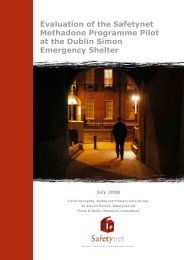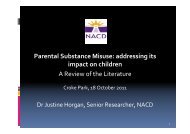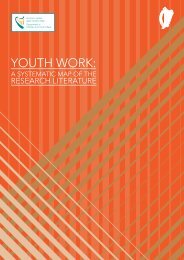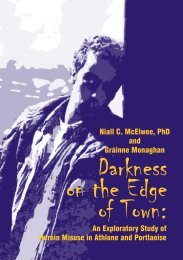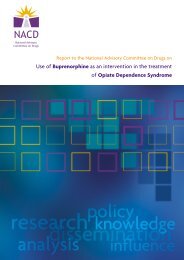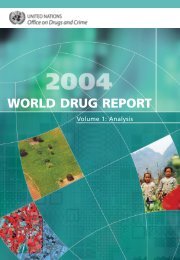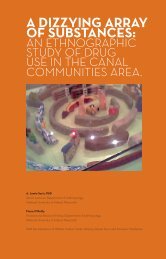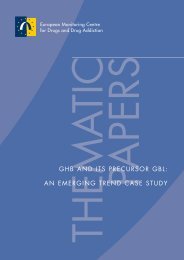Attract<strong>in</strong>g and reta<strong>in</strong><strong>in</strong>g clientsThe Drug Treatment Agency (DTA) <strong>in</strong> <strong>the</strong> UK emphasises a number of key practiceswhich improve <strong>the</strong> success of <strong>coca<strong>in</strong>e</strong> treatment. Accord<strong>in</strong>g to <strong>the</strong> DTA, once <strong>the</strong><strong>in</strong>itial contact with a treatment service is made, rapid <strong>in</strong>take, proactive rem<strong>in</strong>ders,and practical help with attendance improve treatment uptake rates. Once <strong>coca<strong>in</strong>e</strong>users start treatment, <strong>the</strong>y tend to stay longer and respond better if <strong>the</strong>y feel that<strong>the</strong>ir concerns are be<strong>in</strong>g positively addressed and that <strong>the</strong>ir key worker is empathicand understand<strong>in</strong>g. This <strong>in</strong>dicates <strong>the</strong> crucial role that key workers play <strong>in</strong> assess<strong>in</strong>g,motivat<strong>in</strong>g and reta<strong>in</strong><strong>in</strong>g clients. The provision of complementary <strong>the</strong>rapies is importantto attract clients <strong>in</strong>to treatment, enhance <strong>the</strong>ir well-be<strong>in</strong>g and reta<strong>in</strong> <strong>the</strong>m <strong>in</strong> treatment.A similar approach to that <strong>in</strong> <strong>the</strong> UKL has been tried with <strong>in</strong>tranasal <strong>coca<strong>in</strong>e</strong> users <strong>in</strong>Tallaght and was deemed very successful.The Department of Community, Rural and Gaeltacht Affairs funded <strong>the</strong> Tallaghtcommunity-based project <strong>in</strong>volv<strong>in</strong>g St Dom<strong>in</strong>ic’s Community Response Project andKill<strong>in</strong>arden’s Community Addiction Response Programme for problematic <strong>in</strong>tranasal<strong>coca<strong>in</strong>e</strong> users (Goodbody Economic Consultants 2006). The <strong>in</strong>terventions plannedwere advertis<strong>in</strong>g service availability, project meet<strong>in</strong>gs, relationship build<strong>in</strong>g, <strong>in</strong>dividualcare plans, <strong>in</strong>dividual counsell<strong>in</strong>g, and holistic <strong>the</strong>rapies. The project commenced<strong>in</strong> February 2005. The project employed six staff members on a part-time basis. Theservice was provided through two even<strong>in</strong>g sessions and one afternoon session. The<strong>coca<strong>in</strong>e</strong> treatment service was promoted through a media campaign and proactiveoutreach work. The project communicated with <strong>coca<strong>in</strong>e</strong> users and concerned persons bytelephone and received an average of 20 calls per week. Dur<strong>in</strong>g its first year, 99 <strong>coca<strong>in</strong>e</strong>users attended <strong>the</strong> project, of whom 60 (61%) returned more than once. The uptake ofcomplementary treatments, such as acupuncture and Indian head massage, was high. Afur<strong>the</strong>r 60 people were assisted by <strong>the</strong> outreach worker. Seven clients were <strong>in</strong>terviewedat <strong>the</strong> end of <strong>the</strong> project, of whom four were abst<strong>in</strong>ent from all drugs and two said that<strong>the</strong>ir suicidal thoughts had ceased. Accord<strong>in</strong>g to <strong>the</strong> evaluators, Goodbody EconomicConsultants, <strong>the</strong> project was effective and very good value for money.Brief <strong>in</strong>terventionBernste<strong>in</strong> and colleagues (2005) conducted a randomised control trial to determ<strong>in</strong>ewhe<strong>the</strong>r brief motivational counsell<strong>in</strong>g was more effective that written <strong>in</strong>formation<strong>in</strong> reduc<strong>in</strong>g <strong>coca<strong>in</strong>e</strong> use among clients attend<strong>in</strong>g an outpatient cl<strong>in</strong>ic <strong>in</strong> Boston. Sixmonths follow<strong>in</strong>g <strong>in</strong>tervention, <strong>the</strong>y found marg<strong>in</strong>ally higher rates of abst<strong>in</strong>enceamong those who attended brief motivational counsell<strong>in</strong>g than among those whoreceived written <strong>in</strong>formation. For those report<strong>in</strong>g both <strong>coca<strong>in</strong>e</strong> and opiate use, <strong>the</strong>abst<strong>in</strong>ence rates were 22% among those who were given brief motivational counsell<strong>in</strong>g,compared to 17% among those who received <strong>in</strong>formation; among <strong>coca<strong>in</strong>e</strong> users, <strong>the</strong>correspond<strong>in</strong>g abst<strong>in</strong>ence rates were 17% and 13% respectively. It is <strong>in</strong>terest<strong>in</strong>g to<strong>Crack</strong> <strong>coca<strong>in</strong>e</strong> <strong>in</strong> <strong>the</strong> Dubl<strong>in</strong> <strong>region</strong>: an evidence base for a crack <strong>coca<strong>in</strong>e</strong> strategy127
note that provid<strong>in</strong>g <strong>in</strong>formation on <strong>coca<strong>in</strong>e</strong> itself and its associated treatment optionsdid encourage some respondents to seek help. Indeed, despite <strong>the</strong> title of this paper,<strong>the</strong> differences <strong>in</strong> abst<strong>in</strong>ence rates for <strong>the</strong> two <strong>in</strong>terventions were nei<strong>the</strong>r cl<strong>in</strong>icallynor statistically significant. The data presented <strong>in</strong> this paper <strong>in</strong>dicate that <strong>in</strong>formationor brief <strong>in</strong>tervention would be effective if provided at accident and emergency, harmreduction and opiate treatment services. The <strong>in</strong>formation brief or leaflet should cover<strong>the</strong> dangers of <strong>coca<strong>in</strong>e</strong> use, <strong>the</strong> symptoms of dependence and <strong>the</strong> treatment servicesavailable.Cognitive behavioural <strong>the</strong>rapy and counsell<strong>in</strong>gCognitive behavioural <strong>the</strong>rapy is a system of psycho<strong>the</strong>rapy which attempts to reduceexcessive emotional reactions and self-defeat<strong>in</strong>g behaviours by modify<strong>in</strong>g underly<strong>in</strong>gerroneous th<strong>in</strong>k<strong>in</strong>g and maladaptive beliefs. Accord<strong>in</strong>g to experts <strong>in</strong> this area, <strong>the</strong>cognitive approach, when applied to substance abuse, helps <strong>in</strong>dividuals deal with <strong>the</strong>problems lead<strong>in</strong>g to emotional distress and ga<strong>in</strong> a better perspective on <strong>the</strong>ir relianceon drugs. Specific cognitive strategies are said to help <strong>in</strong>dividuals establish stronger<strong>in</strong>ternal controls and reduce <strong>the</strong>ir urges to take drugs. In addition, cognitive <strong>the</strong>rapycan help patients to combat depression, anxiety or anger, which <strong>in</strong>crease addictivebehaviours.S<strong>in</strong>ce <strong>the</strong>re were no systematic reviews <strong>in</strong> <strong>the</strong> Cochrane Library that exam<strong>in</strong>ed <strong>the</strong>evidence of effectiveness of psycho<strong>the</strong>rapeutic <strong>in</strong>terventions (such as cognitivebehavioural <strong>the</strong>rapy) <strong>in</strong> <strong>the</strong> treatment of <strong>coca<strong>in</strong>e</strong> dependence, some <strong>in</strong>dividual studieswere reviewed for <strong>the</strong> purposes of this article.Crits-Christoph and colleagues (1999) exam<strong>in</strong>ed comb<strong>in</strong>ations of psychosocialtreatments for <strong>coca<strong>in</strong>e</strong> dependence. They compared four different treatments –cognitive <strong>the</strong>rapy, psychodynamic <strong>the</strong>rapy, <strong>in</strong>dividual drug counsell<strong>in</strong>g, and groupdrug counsell<strong>in</strong>g alone. The first three treatments mentioned <strong>in</strong>cluded group drugcounsell<strong>in</strong>g along with <strong>the</strong> specific <strong>in</strong>dividual <strong>the</strong>rapy. Treatments were <strong>in</strong>tensive andprovided over a six-month period. The clients were followed up at six and at twelvemonths. The authors found that, when compared to <strong>the</strong> two forms of psycho<strong>the</strong>rapyand to group drug counsell<strong>in</strong>g alone, <strong>in</strong>dividual drug counsell<strong>in</strong>g plus group workshowed <strong>the</strong> greatest improvement <strong>in</strong> <strong>the</strong> number of days <strong>the</strong> clients did not use <strong>coca<strong>in</strong>e</strong>over a one-month period. The authors were surprised by this f<strong>in</strong>d<strong>in</strong>g because <strong>in</strong> 1991Carroll and colleagues reported that relapse-prevention <strong>the</strong>rapy (a form of cognitivebehaviour <strong>the</strong>rapy) was more effective than <strong>in</strong>terpersonal psycho<strong>the</strong>rapy, and hadhigher abst<strong>in</strong>ence and recovery rates. In 1994, Higg<strong>in</strong>s and colleagues reported thatrelapse prevention <strong>the</strong>rapy with <strong>the</strong> addition of <strong>in</strong>centives was more effective thanrelapse prevention <strong>the</strong>rapy alone. The clients who received <strong>in</strong>centives were more likelyto complete <strong>the</strong>ir treatment and had a longer duration of <strong>coca<strong>in</strong>e</strong>-negative ur<strong>in</strong>es.128 <strong>Crack</strong> <strong>coca<strong>in</strong>e</strong> <strong>in</strong> <strong>the</strong> Dubl<strong>in</strong> <strong>region</strong>: an evidence base for a crack <strong>coca<strong>in</strong>e</strong> strategy
- Page 1 and 2:
HRB Research Series6Crack cocaine i
- Page 3 and 4:
This publication should be cited as
- Page 5 and 6:
HRB Research Series publicationsto
- Page 8 and 9:
ContentsList of tables and figures
- Page 10 and 11:
7 Social consequences of crack use
- Page 12 and 13:
List of tables and figuresTablesTab
- Page 14 and 15:
AbbreviationsADRUGNDUHRBISCCSGLDTFN
- Page 16 and 17:
Glossary of termsBenzos: The street
- Page 18 and 19:
Executive summaryBackground and stu
- Page 20 and 21:
phone and buyers are directed to sp
- Page 22 and 23:
Part 1IntroductionCrack cocaine in
- Page 24 and 25:
In the light of these concerns, it
- Page 26 and 27:
extensive reporting in the US about
- Page 28 and 29:
Ten interviews were conducted with
- Page 30 and 31:
also offers potential to trace supp
- Page 32 and 33:
Part 2Crack cocaine in the Dublin r
- Page 34 and 35:
2.2 Criminal justice data - cocaine
- Page 36 and 37:
Prevalence of crack use among homel
- Page 38 and 39:
Local survey dataA survey in 2006 o
- Page 40 and 41:
Respondent 1: I’d say it’s stil
- Page 42 and 43:
3 Dublin crack cocaine market3.0 Ov
- Page 44 and 45:
sold on the street for as little as
- Page 46 and 47:
Like, I was down on M… Street in
- Page 48 and 49:
3.4 Marketing crackFour interviewee
- Page 50 and 51:
While crack was generally bought al
- Page 52 and 53:
• Although a number of dealers, o
- Page 54 and 55:
4.2 Crack use and genderAccording t
- Page 56 and 57:
From about 16 to 21 I would say - t
- Page 58 and 59:
Table 4.4Number of new cases who li
- Page 60 and 61:
5.2 Crack and other drugsMany of th
- Page 62 and 63:
Whether treated cases reported crac
- Page 64 and 65:
cases of intravenous cocaine use, t
- Page 66 and 67:
Table 5.5Number (%) of new cases wh
- Page 68 and 69:
Part 3Consequences of crack useCrac
- Page 70 and 71:
etween heroin, cocaine and crime. T
- Page 72 and 73:
So, they would talk about the kind
- Page 74 and 75:
Crack and prostitutionNine services
- Page 76 and 77:
On the other hand, reports from two
- Page 78 and 79: often with a prevalence of opiate d
- Page 80 and 81: The data provided by the NDTRS in S
- Page 82 and 83: But you know it would be about kind
- Page 84 and 85: So, debt is another significant iss
- Page 86 and 87: 7.6 Key findings• A significant p
- Page 88 and 89: There are considerable long-term ps
- Page 90: 8.3 Psychological consequences of c
- Page 93 and 94: 9 Treating crack use9.0 OverviewIn
- Page 95 and 96: Some services were in a position to
- Page 97 and 98: Both opiate-dependent and non-opiat
- Page 99 and 100: • more outreach work to identify
- Page 101 and 102: 10 Policing crack markets10.0 Overv
- Page 103 and 104: local communities. There is growing
- Page 105 and 106: He’d know me, I’d know him, you
- Page 107 and 108: Table 10.1 Number of new cases who
- Page 109 and 110: 108 Crack cocaine in the Dublin reg
- Page 111 and 112: 11 Discussion and research implicat
- Page 113 and 114: 11.2 Responding to crack markets an
- Page 115 and 116: 11.3 Reducing the harm that crack c
- Page 117 and 118: Shoplifting, burglary and robbery w
- Page 119 and 120: Bourgois P (2003b) Crack and the po
- Page 121 and 122: Furey M and Browne C (2004) Opiate
- Page 123 and 124: Loughran H and McCann ME (2006) A c
- Page 125 and 126: San Diego Police Department (1998)
- Page 127: Appendix A:An evidence base for tre
- Page 131 and 132: MedicationsA number of studies have
- Page 133 and 134: interpersonal psychotherapy. Americ
- Page 135 and 136: Jurisdiction Intervention/Descripti
- Page 137 and 138: Jurisdiction Intervention/Descripti
- Page 139 and 140: Appendix C:Recent HRB series public
- Page 141 and 142: 140 Crack cocaine in the Dublin reg




